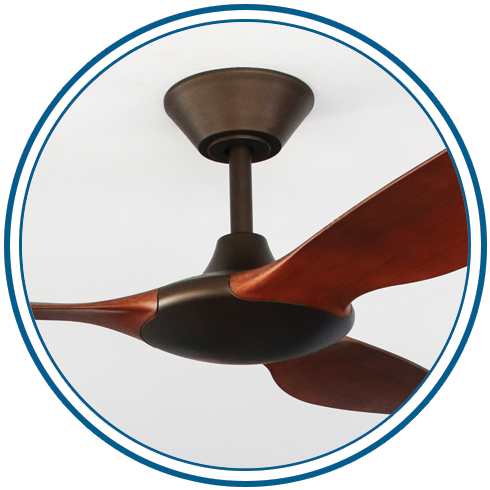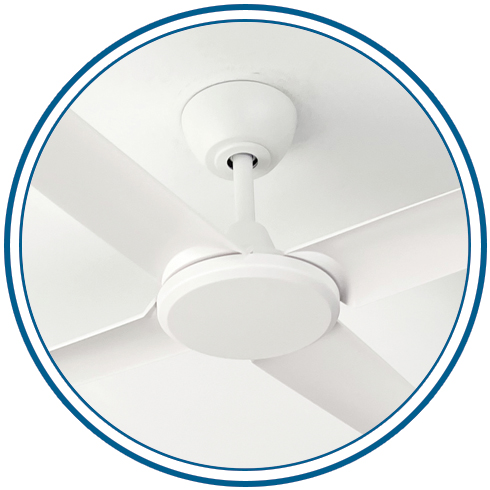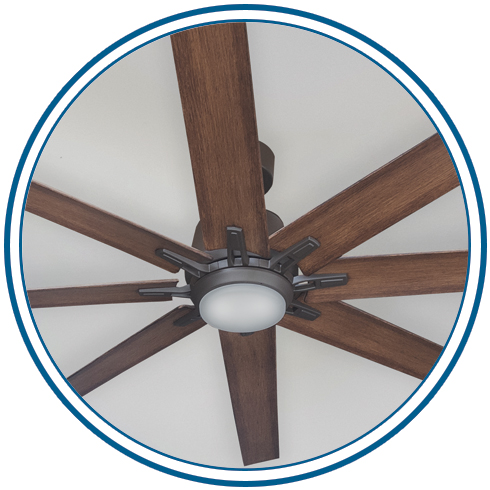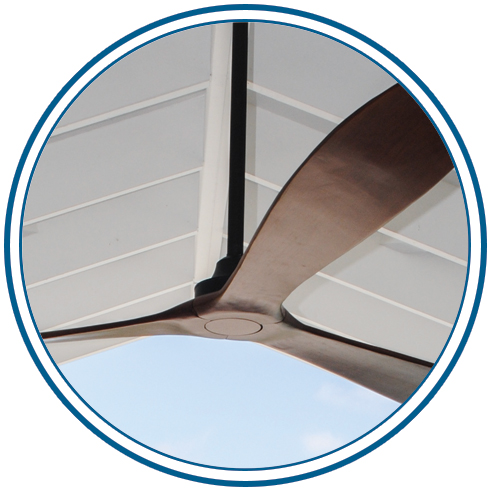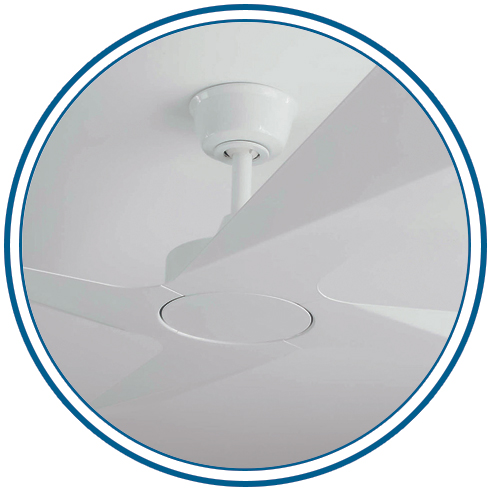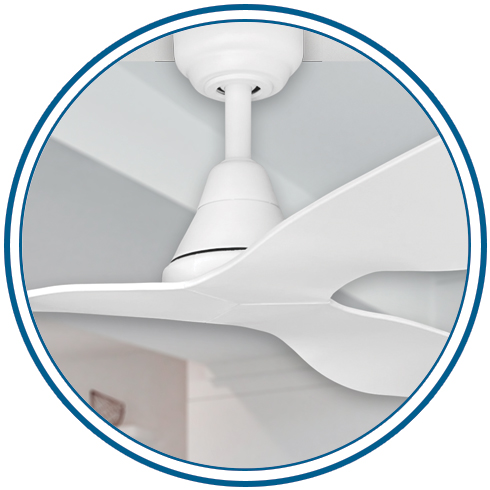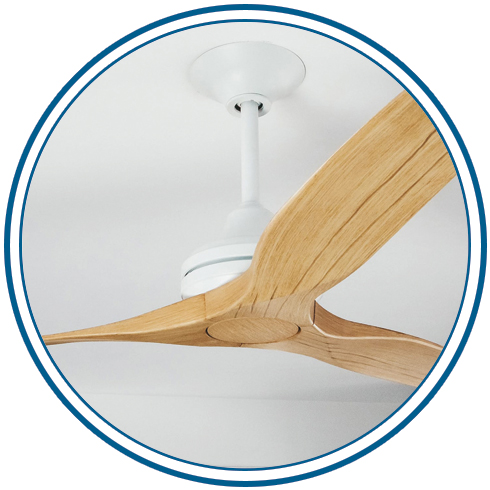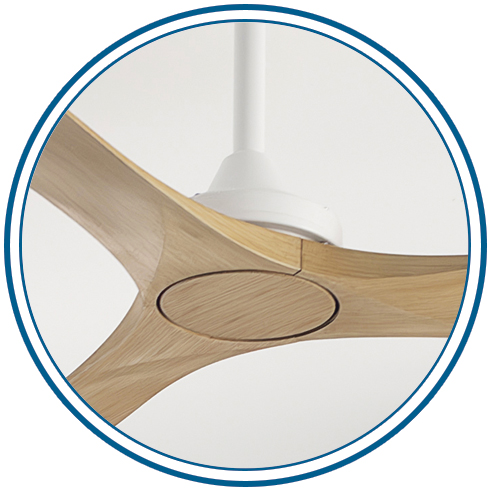We’ve compiled a list of Frequently Asked Questions for your convenience. Should you not find your question answered, please don’t hesitate to get in touch with our friendly team.
We’ve compiled a list of popular questions below; you may also be interested in one of these other FAQs:
Common Ceiling Fan Questions
Can I install my own ceiling fan?
All ceiling fans must be installed by a licensed electrician and you should be issued with a Certificate of Electrical compliance.
How high should I hang my ceiling fan?
Minimum Height: The lower edge of a ceiling fan blade must be at least 2.1m (7ft) above the floor to comply with Australian building codes. For low ceilings, if possible select ceilings fans with features to minimise their encroachment into a room.
The more air (space) there is above a ceiling fan, the more airflow the fan will be able to produce. We would recommend aiming for at least 30cm or greater of space above your fan to ensure optimal efficiency.
For higher ceiling fans, we recommend trying to position your ceiling fan anywhere between 2.4m and 2.7m to ensure optimal performance.
Refer to our Ceiling Fan Size Guide for more information on how high to hang your ceiling fan.
Can I hang my ceiling fan on a sloped ceiling?
When buying a new ceiling fan, confirm the fan is compatible with sloped mounting. Many ceiling fans are designed to fit sloped ceilings with angles, also known as a pitch, up to 30 degrees. However, if your ceiling has a pitch greater than 30 degrees, you will need a sloped ceiling adapter for a proper and secure installation.
Refer to our Sloped Ceiling Kit for more information.
Do I need a downrod for my ceiling fan?
You would only need to have an extension rod if your ceiling is above a certain height to efficiently benefit from the airflow your fan gives. Generally, extensions rods come in 90cm and 180 cm which can be cut to size by your Electrician.
Refer to our Ceiling Fan Size Guide for more information on how high to hang your ceiling fan.
Should my ceiling fan have 3, 4 or 5 blades?
The short answer is don’t focus too much on the number of blades. Yes, blades are an important part of your ceiling fan and the number of blades does impact ceiling fan performance. However, there are many factors that influence ceiling fan performance – blade pitch, blade aerodynamics, motor performance – which all need to be considered in order to determine overall performance.
So the number of blades, on its own, is not a reliable indicator of performance. A three blade ceiling fan may be better or worse than a four-blade fan, a four-blade fan may be better or worse than a five-blade fan, and so on. We have published our Fan Performance Indicator (FPI) on all our Data Sheets and also on every product page. The FPI should be used to help identify models that will offer you the right type of cooling based on your personal preference and requirements.
Refer to our Ceiling Fan Performance Guide for more information on choosing the right airflow for your space.
Are timber, metal or plastic blades better for my ceiling fan?
Timber blades are generally quieter than metal blades because they have a better cross-sectional profile to generate non-turbulent airflow. Metal blades with a sharp leading edge create more turbulence resulting in a whirr reminiscent of a helicopter. Plastic blades (all-weather polymer) are typically the best option as they are generally quieter than metal blades, however can be moulded into more aerodynamic shapes and therefore often provide better airflow than timber blades.
What should I look for in my outdoor ceiling fan?
Choosing an outdoor ceiling fan, you must take into consideration the climate you live in. If you are living near the beach or near a saltwater pool fans are likely to rust. So, a 316 marine grade fan or a full plastic fan would be a must.
Otherwise, most of our ceiling fans can be installed in outdoor, undercover settings where they will not be exposed directly to rain. Look for ceiling fans that have powder coated finishes and use polymer blades (high-grade ABS plastic) to make sure your fan can resist the elements. Avoid plated finishes (such as Brushed Nickel) and normal steel fans.
What is the summer/winter setting on my ceiling fan?
The majority of AC ceiling fans have a summer/winter switch located on the motor itself, or a reversing button on the remote control for DC ceiling fans.
When you have your fan in summer mode the fan rotates anticlockwise to provide a cooling breeze beneath the fan and circulate air around the room.
Conversely, having the fan on winter mode the fan rotates clockwise to bring the warm air down the walls from the ceiling without producing a strong draft beneath the fan to help circulate warm air around the room.
Why are DC ceiling fans called ‘DC’ when they connect to the same household electricity supply?
AC ceiling fans use induction motors. These motors use AC electricity directly from the power grid to create magnetic fields in both the stator and rotor. Because this AC power is directly coupled to the motor windings it can’t be changed except in voltage magnitude. The speed control switch varies the magnitude of the power and thus the speed of the fan.
A ‘DC Fan’ gets AC energy from the power grid but its electronic control module changes that power to DC. This DC power can then be precisely manipulated by the module’s microprocessor to re-generate power that’s controlled in three ways (voltage, current and time). The use of permanent magnets in the fan rotor and precisely generated power makes a ‘DC Fan’ motor very efficient.
What is Ripple Control Signal noise?
A hum or buzz from your ceiling fan is the most common complaint arising from ripple control, which is generated when a transformer or the motor windings in a switched-on appliance resonate with the ripple control frequency, usually between 300Hz and 1300Hz.
The noise is often, but not always, intermittent depending on when the ripple control signals are being transmitted.
People often notice it most acutely in the night when off-peak hot water systems are turned on.
Ripple control is a way in which electrical companies use a superimposed frequency on standard 50Hz AC power supplies, which are commonly found in most (if not all) Australian households.
Simply put, electrical companies are controlling and managing off-peak power loads on their distribution networks. The frequency is used to control hot water heaters, street lights and water pumps through their remote receiver to control the power going to and from each utility. Ripple control may also be used to signal high network load periods for major customers to allow them to reduce power consumption.
Ripple control and electrical harmonics noise is not the result of a mechanical fault with your ceiling fan. As such we do not cover either occurrence under our warranty. Where ripple control noise is found to be at fault, the customer will have to acquire a filter and have it installed by their electrician at their expense.
If you make a warranty-based service call and ripple control or electrical harmonics noise is diagnosed as the problem you may be charged the call-out fee for the electrician.
How do I clean and maintain my ceiling fan?
Clean your fan as you would any other household electrical appliance. Use a soft dry cloth to lightly remove dust and debris at least every 3 months.
Built-up grime such as pet dander or dirt caused by moisture will cause metal parts especially blades to corrode or rust. Regularly remove grime with a dampened (not wet) cloth and dry afterwards.
In humid climates, air conditioning will make the fan blades cold and when warm/humid air enters the room it will cause moisture to condense on the fan blades. This may cause dirt and corrosion to form more quickly.



